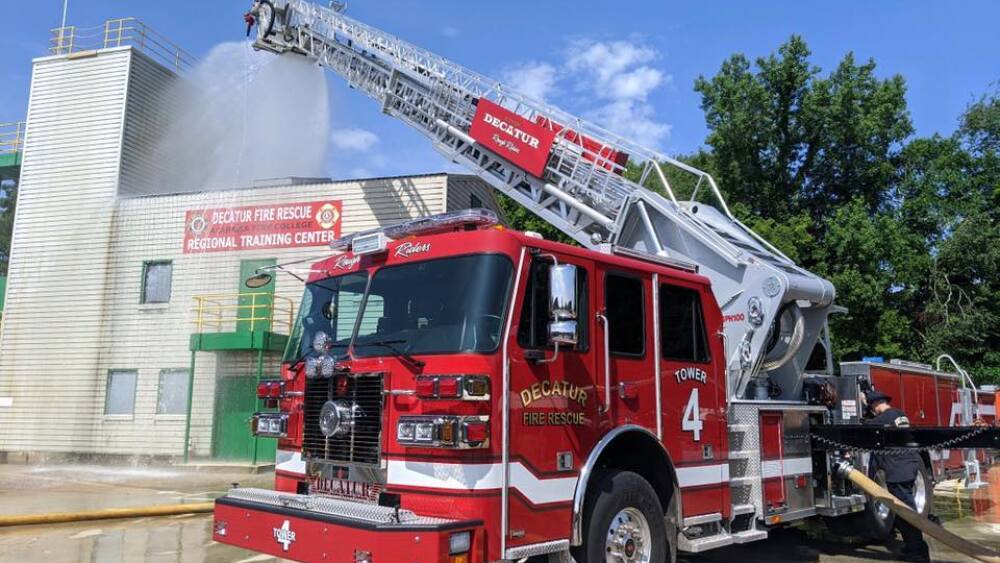By David Gambino
The Decatur Daily
DECATUR, Ala. — Decatur Fire & Rescue is accepting applications through Feb. 16 from individuals with no firefighting experience in its first open recruitment period in over a year.
“We just don’t do the open-hire process a lot,” said Decatur Fire & Rescue Lt. Brandon Sivley on Tuesday. “We do lateral hires, which are firefighters who already have the credentials needed to come on board and not really have to go through a recruit-style process.
“But the open hire, which is basically somebody with little-to-no fire knowledge, can apply and test and go through the recruit school process to then become an active firefighter.”
The minimum starting pay for the full-time position is $49,599.40 yearly, with a maximum starting pay of $73,630.59 dependent on previous education, training or experience.
[RELATED: What Firefighters Want in 2024 survey now live!]
Firefighter Kendall Michael joined Decatur Fire & Rescue after applying during an open recruitment period in 2022.
“I went in not knowing anything about the Fire Department,” she said. “Recruit school is going to be your whole life for the two months that you’re in it, and you’ve got to apply yourself. You can’t just go into it without being physically ready.”
Applicants must be at least 18 years old with a high school diploma or GED equivalent to be considered. Preferential consideration will be given to candidates who possess an Alabama Paramedic License.
Sivley said applicants will be considered if they can pass the Candidate Physical Ability Test (CPAT).
“There are really no predeterminations as far as physical limitations, because we had a guy who entered the recruit school as a self-sponsor,” he said. “He actually had a missing hand, so he had an adaptive type of implant that he could wear while doing some of the drills and stuff. From a physical standpoint, if they can try and achieve it, we’re not going to suppress that.”
The CPAT sees applicants navigate a series of eight fire scene events, such as a stair climb while weighed down with a 50-pound vest and other equipment to simulate the experience of wearing a full firefighter kit.
In addition to the CPAT, applicants must also pass a standardized written test. Michael said the test is like “any other” standardized test one might take in high school.
“After the written test, you get to go through the interview process,” she said. “You get scored based on both of those. They rank each applicant based on that, and based on how they feel you’ll fit in the department, they offer however many jobs they have openings for.”
Sivley said the department will have 13 openings, but some of those positions will be filled in the next few weeks by already-certified candidates with pending job offers.
For open-hire candidates who receive and accept a job offer, the next step is recruit school and EMT training. Recruit school is offered in Decatur. The typical length of training is 12-18 weeks, according to Sivley, and depends on what credentials are required of the candidates and what credentials they might already bring to the table.
“It’s rigorous,” Michael said of recruit school, where the days can be up to 12 hours long. “It’s difficult. You definitely have to go in with the decision made that you’re going to pass, because if you’re not sure, you’re probably not going to make it.”
After recruit school, firefighters are then sent to “the floor,” or to an actual fire station.
“They prepare you well in Decatur,” Michael said. “I like it a lot. The new schedule is very nice.”
Decatur Fire & Rescue earlier this month switched to a 48-96 work schedule, meaning firefighters work for two 24-hour days before having four days off in a row. Under the old system, firefighters worked for 24 hours before having two days off in a row.
“There are not many firefighters that work just a Fire Department job,” Sivley said. “You typically have people that have other jobs when they’re off-duty, and so this work schedule opens it up to have the ability to do something else on your off days, whether that be work or travel or just spending more time with the family.”
Michael said firefighters are used to working long hours and that working 48 hours straight doesn’t really feel like two days.
“You just got to be ready for anything,” she said. “Most of the time, it’s not going to be anything crazy, but every once in a while, you get those crazy calls, and you have to be ready for it all the time.”
Benefits to the position include tuition assistance, medical/dental/vision insurance, vacation, sick leave, life insurance and long-term disability. Firefighters also receive Tier 1 retirement benefits under the Retirement Systems of Alabama, making them eligible for retirement after 25 years of service or, if over 60 years old, after 10 years of service.
Sivley said the most important part of the process for aspiring firefighters is making sure their application is submitted before the hiring window closes.
“We want to encourage men and women to apply,” he said. “We have two women who are actively serving in the department, and they are both (in fire stations). One is actually an officer, so she’s advanced through the career ladder. That’s always something that we like to brag about.”
(c)2024 The Decatur Daily (Decatur, Ala.)
Visit The Decatur Daily (Decatur, Ala.) at www.decaturdaily.com
Distributed by Tribune Content Agency, LLC.








